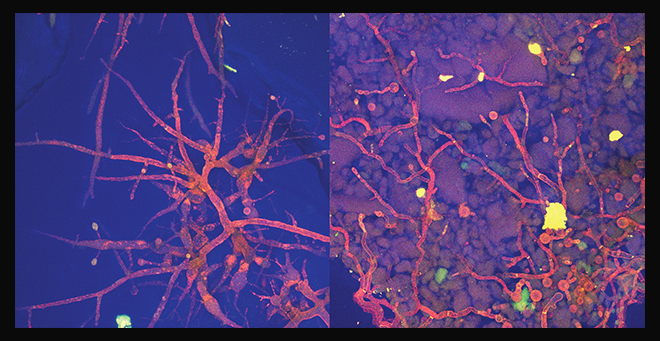
The image at left shows fungus grown in water; at right is fungus grown in a transparent soil system. |
A new study shows that transparent soil substitutes can be used to replicate the interactions of bacteria and fungi in soil, opening up a new approach to learning how soil microbes contribute to a healthy ecosystem. Elizabeth Shank, PhD, associate professor of microbiology & physiological systems and senior author on the study, describes how using two transparent soil substitutes allowed scientists to follow how soil bacteria rely on fungi to help them survive extended dry periods. The research is published in the online journal eLife.
“To advance the study of soil processes, we used transparent soil substitutes that allowed us to use microscopes and other experimental techniques to see and measure the activity of soil bacteria and determine how this activity depends on the fungi,” said lead author Kriti Sharma, PhD, a former member of the Shank laboratory who is now a postdoctoral scholar at Caltech.
The findings indicate that these soil-like substrates may enable researchers to observe the complex interactions of the myriad microscopic creatures that live in soil. This ability is crucial to help researchers better understand the role that soil and soil microbes play in healthy ecosystems.
Millions of microscopic organisms such as fungi and bacteria live in the soil. They are essential for healthy ecosystems because they support the growth of plants and capture and store carbon from the atmosphere. But studying these processes in real soil can be challenging, in part because of soil’s opacity and complexity. While other fields, such as hydrology and geoengineering, have used transparent soil systems in research for decades, these systems rely heavily on silicone and oil based substitutes that don’t support life, making them incompatible for research on bacteria or other living organisms.
Dr. Sharma and collaborators successfully grew soil bacteria and fungi in two transparent soil substitutes. One was a synthetic substance called Nafion and the other was a naturally occurring crystal called cryolite. They also demonstrated that it was possible to observe living microbes in these substitutes using a microscope and to measure the organisms’ overall metabolic activity and uptake of carbon using a technique called Raman microspectroscopy.
Next, they used the soil substitutes to study what happens to bacteria when soil goes from being dried out to wet again. The experiments showed that while many soil bacteria die or become inactive when soil dries out, bacteria living near dead fungi remain active and use the fungi as a source for carbon. “In this way, fungi promote the activity of soil bacteria in changing environmental conditions,” Sharma said.
The transparent soil systems reported in the study will likely be used by many other researchers who study soil ecology, added Dr. Shank. This work may help scientists identify novel bioactive compounds that have potential as therapeutics and chemical tools to manipulate microbial communities to improve host health and the environment.
“For example, they could be used to explore how interactions between bacteria, fungi and other microscopic creatures living in soil help support the growth of crops,” Shank said. “Or to better understand how carbon is stored and released from soil, which may be critical to combating climate change. Overall, these transparent soil substitutes are powerful tools that will help us answer many outstanding questions in soil microbial ecology.”